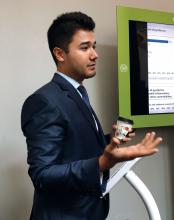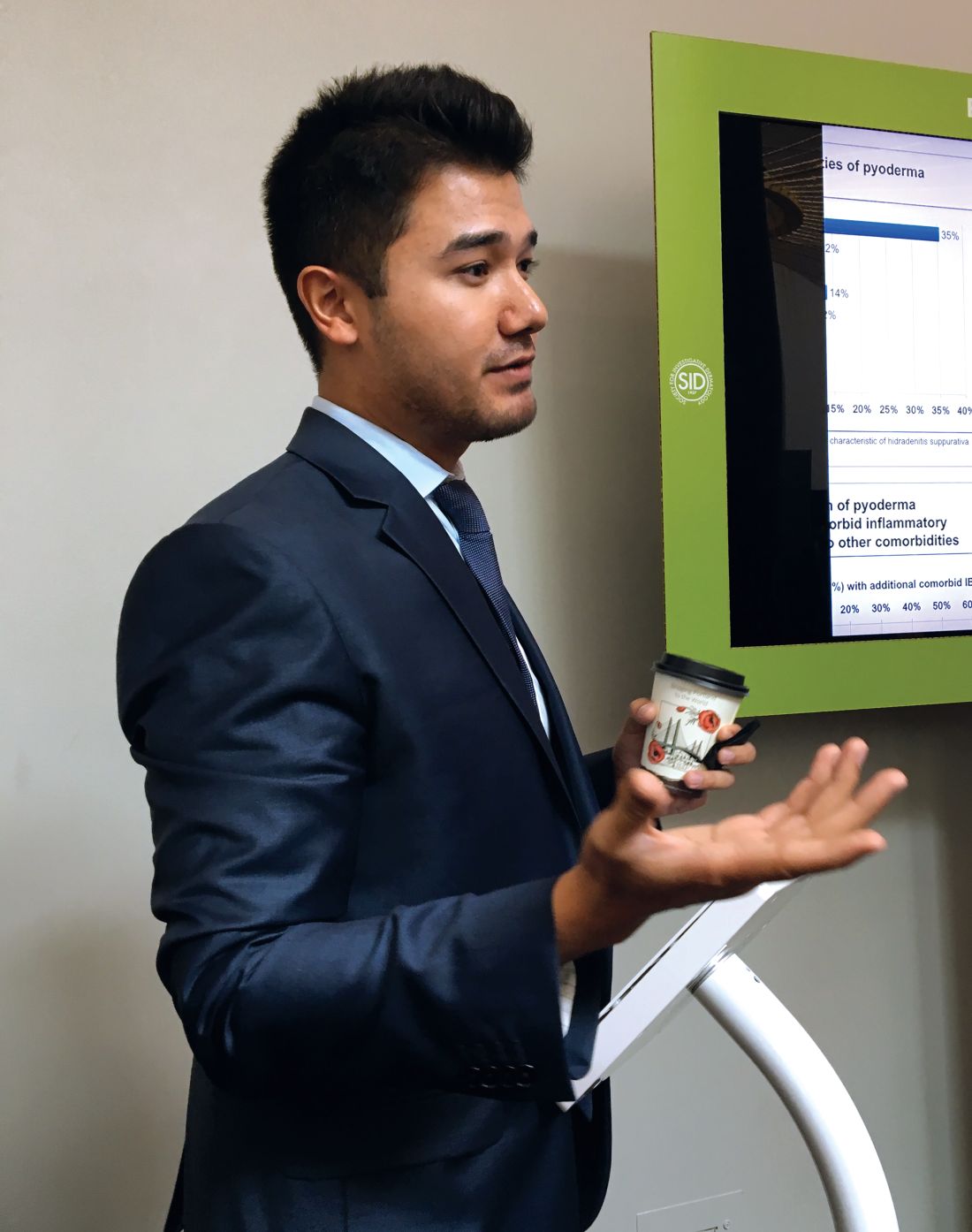User login
PORTLAND, ORE. – Comorbidities were common in patients with pyoderma gangrenosum (PG), in a single-center retrospective cohort study of 130 patients.
These comorbid diagnoses were not only clinically significant in themselves, but also were associated with changes in treatment efficacy, highlighting the need for holistic surveillance of patients with PG, Alexander Fischer, MPH, said during an oral presentation of his poster at the annual meeting of the Society for Investigative Dermatology. “We should really be screening patients with PG for multiple comorbid conditions,” he emphasized.
The study included patients seen for PG at Johns Hopkins Medicine, Baltimore, between 2006 and 2015. The most common comorbidity was inflammatory bowel disease (35%), followed by hidradenitis suppurativa (14%), rheumatoid arthritis (12%), monoclonal gammopathy (12%), leukemia (2%), and lymphoma (2%). “Interestingly, a substantial proportion of patients had multiple systemic diseases,” Mr. Fischer said. “For example, among our PG patients with rheumatoid arthritis, over a third also had comorbid inflammatory bowel disease. We saw this pattern repeat itself in patients with comorbid hidradenitis suppurativa, and also in patients with comorbid monoclonal gammopathy.”
The researchers used rigorous inclusion and exclusion criteria to verify the diagnosis of PG, said Mr. Fischer, a medical student at Johns Hopkins University, Baltimore, who conducted the analysis under the mentorship of Gerald S. Lazarus, MD, professor of dermatology and medicine at Johns Hopkins Bayview Medical Center. A total of 69% of patients were female, 58% were white, and 35% were black. The average age of PG onset was 47 years. Notably, patients with comorbid hidradenitis suppurativa (HS) had an earlier age of PG onset and were more likely to be black than were patients without comorbid HS, and 53% of young black females with PG onset also had HS.
The investigators explored whether the effect of systemic PG therapies varied in the presence of comorbidities. In a crude analysis of 32 patients who received infliximab (Remicade) for PG, those with comorbid HS were significantly more likely to achieve complete healing of PG wounds (83%) than were those without comorbid HS (31%; P = .03), Mr. Fischer reported. “Our sample size was small for this analysis, but we thought this was an interesting finding that perhaps warrants further investigation,” he said. “We need to do larger longitudinal studies that account for wound characteristics and that include more therapies to get a better grasp of this question.”
Only 57% of patients in this study had their diagnosis confirmed by biopsy, Mr. Fischer noted. However, this study generally resembles others in terms of comorbidity prevalence. For example, a single-center study of 103 patients with PG at Brigham and Women’s Hospital, Boston, found that 34% of patients had comorbid IBD compared with 35% in the Hopkins cohort (Br J Dermatol. 2011 Dec;165[6]:1244-50). In a study of 121 patients with PG at three wound care centers in Germany, 10% of patients had IBD, but 14% had rheumatologic conditions and 7% had blood cancers (J Dtsch Dermatol Ges. 2016 Oct;14[10]:1023-30).
Mr. Fischer cited no external funding sources. He had no relevant financial disclosures.
PORTLAND, ORE. – Comorbidities were common in patients with pyoderma gangrenosum (PG), in a single-center retrospective cohort study of 130 patients.
These comorbid diagnoses were not only clinically significant in themselves, but also were associated with changes in treatment efficacy, highlighting the need for holistic surveillance of patients with PG, Alexander Fischer, MPH, said during an oral presentation of his poster at the annual meeting of the Society for Investigative Dermatology. “We should really be screening patients with PG for multiple comorbid conditions,” he emphasized.
The study included patients seen for PG at Johns Hopkins Medicine, Baltimore, between 2006 and 2015. The most common comorbidity was inflammatory bowel disease (35%), followed by hidradenitis suppurativa (14%), rheumatoid arthritis (12%), monoclonal gammopathy (12%), leukemia (2%), and lymphoma (2%). “Interestingly, a substantial proportion of patients had multiple systemic diseases,” Mr. Fischer said. “For example, among our PG patients with rheumatoid arthritis, over a third also had comorbid inflammatory bowel disease. We saw this pattern repeat itself in patients with comorbid hidradenitis suppurativa, and also in patients with comorbid monoclonal gammopathy.”
The researchers used rigorous inclusion and exclusion criteria to verify the diagnosis of PG, said Mr. Fischer, a medical student at Johns Hopkins University, Baltimore, who conducted the analysis under the mentorship of Gerald S. Lazarus, MD, professor of dermatology and medicine at Johns Hopkins Bayview Medical Center. A total of 69% of patients were female, 58% were white, and 35% were black. The average age of PG onset was 47 years. Notably, patients with comorbid hidradenitis suppurativa (HS) had an earlier age of PG onset and were more likely to be black than were patients without comorbid HS, and 53% of young black females with PG onset also had HS.
The investigators explored whether the effect of systemic PG therapies varied in the presence of comorbidities. In a crude analysis of 32 patients who received infliximab (Remicade) for PG, those with comorbid HS were significantly more likely to achieve complete healing of PG wounds (83%) than were those without comorbid HS (31%; P = .03), Mr. Fischer reported. “Our sample size was small for this analysis, but we thought this was an interesting finding that perhaps warrants further investigation,” he said. “We need to do larger longitudinal studies that account for wound characteristics and that include more therapies to get a better grasp of this question.”
Only 57% of patients in this study had their diagnosis confirmed by biopsy, Mr. Fischer noted. However, this study generally resembles others in terms of comorbidity prevalence. For example, a single-center study of 103 patients with PG at Brigham and Women’s Hospital, Boston, found that 34% of patients had comorbid IBD compared with 35% in the Hopkins cohort (Br J Dermatol. 2011 Dec;165[6]:1244-50). In a study of 121 patients with PG at three wound care centers in Germany, 10% of patients had IBD, but 14% had rheumatologic conditions and 7% had blood cancers (J Dtsch Dermatol Ges. 2016 Oct;14[10]:1023-30).
Mr. Fischer cited no external funding sources. He had no relevant financial disclosures.
PORTLAND, ORE. – Comorbidities were common in patients with pyoderma gangrenosum (PG), in a single-center retrospective cohort study of 130 patients.
These comorbid diagnoses were not only clinically significant in themselves, but also were associated with changes in treatment efficacy, highlighting the need for holistic surveillance of patients with PG, Alexander Fischer, MPH, said during an oral presentation of his poster at the annual meeting of the Society for Investigative Dermatology. “We should really be screening patients with PG for multiple comorbid conditions,” he emphasized.
The study included patients seen for PG at Johns Hopkins Medicine, Baltimore, between 2006 and 2015. The most common comorbidity was inflammatory bowel disease (35%), followed by hidradenitis suppurativa (14%), rheumatoid arthritis (12%), monoclonal gammopathy (12%), leukemia (2%), and lymphoma (2%). “Interestingly, a substantial proportion of patients had multiple systemic diseases,” Mr. Fischer said. “For example, among our PG patients with rheumatoid arthritis, over a third also had comorbid inflammatory bowel disease. We saw this pattern repeat itself in patients with comorbid hidradenitis suppurativa, and also in patients with comorbid monoclonal gammopathy.”
The researchers used rigorous inclusion and exclusion criteria to verify the diagnosis of PG, said Mr. Fischer, a medical student at Johns Hopkins University, Baltimore, who conducted the analysis under the mentorship of Gerald S. Lazarus, MD, professor of dermatology and medicine at Johns Hopkins Bayview Medical Center. A total of 69% of patients were female, 58% were white, and 35% were black. The average age of PG onset was 47 years. Notably, patients with comorbid hidradenitis suppurativa (HS) had an earlier age of PG onset and were more likely to be black than were patients without comorbid HS, and 53% of young black females with PG onset also had HS.
The investigators explored whether the effect of systemic PG therapies varied in the presence of comorbidities. In a crude analysis of 32 patients who received infliximab (Remicade) for PG, those with comorbid HS were significantly more likely to achieve complete healing of PG wounds (83%) than were those without comorbid HS (31%; P = .03), Mr. Fischer reported. “Our sample size was small for this analysis, but we thought this was an interesting finding that perhaps warrants further investigation,” he said. “We need to do larger longitudinal studies that account for wound characteristics and that include more therapies to get a better grasp of this question.”
Only 57% of patients in this study had their diagnosis confirmed by biopsy, Mr. Fischer noted. However, this study generally resembles others in terms of comorbidity prevalence. For example, a single-center study of 103 patients with PG at Brigham and Women’s Hospital, Boston, found that 34% of patients had comorbid IBD compared with 35% in the Hopkins cohort (Br J Dermatol. 2011 Dec;165[6]:1244-50). In a study of 121 patients with PG at three wound care centers in Germany, 10% of patients had IBD, but 14% had rheumatologic conditions and 7% had blood cancers (J Dtsch Dermatol Ges. 2016 Oct;14[10]:1023-30).
Mr. Fischer cited no external funding sources. He had no relevant financial disclosures.
AT SID 2017
Key clinical point: Carefully screen for comorbidities when patients have pyoderma gangrenosum (PG).
Major finding: The most common comorbidity was inflammatory bowel disease (35%), followed by hidradenitis suppurativa (14%), rheumatoid arthritis (12%), monoclonal gammopathy (12%), leukemia (2%), and lymphoma (2%).
Data source: A single-center retrospective study of 130 patients seen for pyoderma gangrenosum between 2006 and 2015.
Disclosures: Mr. Fischer cited no external funding sources. He had no relevant financial disclosures.

